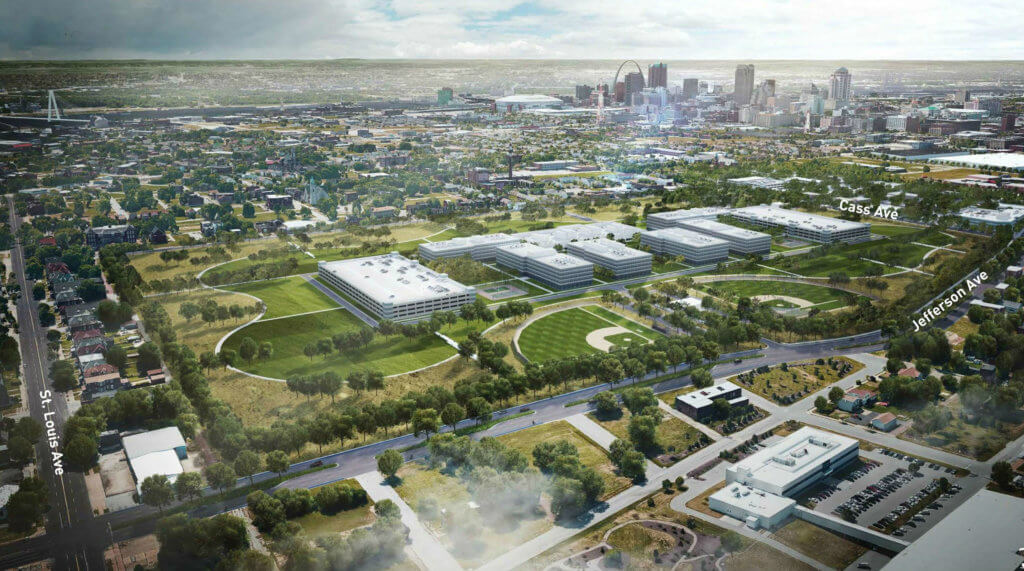Missouri Is Leading The 21st Century Geospatial Ecosystem
- September 16, 2021

“A 21st Century Geospatial Ecosystem requires the combined efforts of government, industry and academia to provide the enterprise data and services needed for informed decision-making, to increase our knowledge of the world, and to improve quality of life and societal conditions.”
That was the vision of the Geo-Resolution 2021 conference that took place this week in St. Louis, Missouri. The conference focused on building a 21st century geospatial ecosystem, and Missouri was the obvious choice to host the event.
Geospatial analysis and cybersecurity are thriving sectors in Missouri, with solid foundations due to the presence of the National Geospatial-Intelligence Agency (NGA), and their thousands of employees.
NGA broke ground on its new western regional headquarters in north St. Louis, Missouri, in 2016. Scheduled to open in 2025, NGA West represents a $1.7 billion investment and exemplifies the explosive growth of the geospatial ecosystem in St. Louis, of which NGA is just one active member.
NGA also recently opened its first unclassified innovation center, called Moonshot Labs, inside the T-REX incubator in downtown St. Louis, Missouri. Moonshot Labs spans about 12,000 square feet on T-REX’s third floor and is designed to provide a software factory and digital maker space to drive geospatial technology innovation among the public and private sector.
Moonshot Labs provides a one-of-a-kind environment bringing together NGA, academia and industry to develop technologies focused on national security. NGA plans to house software developers within its Moonshot Labs facility, with other agency employees like technologies and data-science employees expected to be “in-residence” there.
“Every time I entered the building, I feel the positive energy,” NGA Director Vice Adm. Robert Sharp said of T-REX. “I can feel the potential, the innovative future-focus collaborative spirit of everyone who works there.”
The name “Moonshot Labs” stems from the nation’s efforts to get to the moon in the 1960s. In fact, NGA Director Vice Adm. Sharp recently sat down to discuss the organization’s 25-year history and the ‘Moonshot’ operational effort to face a future as challenging as our nation’s first journey to the moon.
Harris-Stowe State University (HSSU) recently opened a satellite location at the T-REX incubator in downtown St. Louis. The GeoHornet Lab, named for the university’s mascot, focuses on education and career development opportunities in the geospatial technology industry.
The new lab serves as an operation center for activities under an agreement announced in 2020 between HSSU and NGA to collaborate on developing future STEM educators and encouraging interest in related topics among students.

Esri, a California-based geospatial technology company, also announced that it has opened a new office in the T-REX downtown incubator. Esri provides startups in the Geospatial Innovation Center with technology tools and resources through its Esri Startup program, which gives qualified companies access to its ArcGIS Developers software tools for free. The company’s startup program is designed to help companies include mapping technology and location intelligence components into the products they develop.
Missouri’s leadership in geospatial analysis is due in large part to the available talent pool in the region. And thanks to partnerships between NGA and several of the world-class universities and organizations that call Missouri home, that talent pool is set for continued growth for years to come.
The University of Missouri–St. Louis (UMSL) is partnering with other leaders from St. Louis’ public and private sectors on a new initiative to bolster the region’s rapidly growing geospatial sector and develop a strategic plan for the future.
“Because of the new NGA campus, the future for geospatial technology is very bright in this region,” said Andrew Kersten, Dean of the College of Arts and Sciences at UMSL. “UMSL, as St. Louis’ public, land-grant, research-intensive university, will make powerful contributions, encouraging innovation and boosting economic development.”
The new initiative, called GeoFutures, will work to create a shared vision and align the efforts of many people and institutions towards the common goal of making St. Louis the nation’s geospatial center of excellence.
Additionally, St. Louis, Missouri-based Maryville University’s Simon School of Business recently announced plans to add geospatial technology to its curriculum as it focuses on cultivating talent for St. Louis’ budding geotech sector. Maryville’s geospatial program is designed to provide students the opportunity to see how geospatial analysis and technology can be used in a variety of industries.
And Saint Louis University signed a collaborative research and development agreement with NGA in 2019 for geospatial research, training and innovation initiatives.
“Because of SLU’s diverse geospatial research and training portfolio, we are well positioned to support the NGA’s work,” said Fred Pestello, President of Saint Louis University. “Our expertise is an asset for the agency as well as the region, and I am pleased that we will be able to partner with the NGA on their vital work.”
It is this combination of collaboration, investment, and talent that sets Missouri apart as a true leader in geospatial analysis. And it is these factors, and more, that will see Missouri continue to lead the way in fostering the 21st century geospatial ecosystem.
What Next?
- Talk to our CEO, Subash Alias, about business expansion opportunities at 314.932.3973 or via our contact form.
- Check out our available certified sites & buildings for your site selection needs.
- See how Missouri’s business climate ranks in comparison to other states in the U.S.
- Learn more about why Missouri is a top state for geospatial innovation.